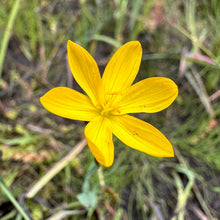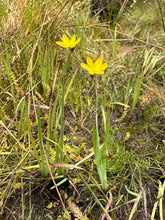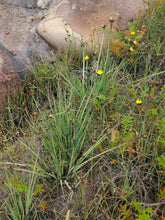
Sisyrinchium californicum
Golden-eyed grass, like its blue-eyed cousin, is actually not a grass at all - but rather a sweet, petit iris that thrives in moist, sunny areas. It produces slender, grass-like foliage (hence the name) that stays green for most of the year. In late spring or early summer, dainty, star-shaped golden flowers appear, attracting hummingbirds and insect pollinators. This species practices a fascinating behavior called nyctinasty where a plant moves in response to changes in light, opening during the day and closing at night - very demure! As summer progresses, flowers transition to dry dark or pale-brown capsulated fruits with one to several seeds inside that eventually self-sow in the most inviting fashion.
- Plant type/canopy layer: deciduous, perennial, herbaceous plant
- Size at maturity: 8-24" tall, 6-12" wide
- Light requirements: full sun to part shade
- Moisture requirements: moist to wet soil
- Bloom time: May - August
- Growth rate/ease: medium growth rate, easy to grow
- Wildlife support: flowers attract and provide nectar for hummingbirds, adult butterflies, bees and other insect pollinators; overall plant attracts and supports beneficial and pest eating insects
- Native habitat/range: found in wet areas and marshes from southern Vancouver Island, British Columbia, Canada to southern California. Portland Plant List - no.
- Special features & uses: landscape uses include rock gardens, wet meadows, pollinator gardens and raingardens
Gardening with Golden-Eyed Grass: This sweet little perennial thrives in moist to wet, well-drained soils and full sun to partial shade, making it well-suited for wet meadows, streambanks, and rain gardens. That said - it can survive going bone dry periodically in the summer months and often does not need supplemental water once established in the right places. Its compact form and semi-evergreen foliage function beautifully for edging water features or enhancing native plant borders in moist, sunny spots. As clumps become larger, they can also be divided and moved around. Always separate clumps in fall or early spring, outside of the main growing season, when soils are moist and temps cooler.
Photo Credits 1 & 2 (flower closeup, form/habit): © Matt Berger, some rights reserved (CC-BY)
Photo Credit 3 (wet meadow): © Ken-ichi Ueda, some rights reserved (CC-BY)
Photo Credit 4 (in a meadow): © Eric Knight, some rights reserved (CC-BY)







